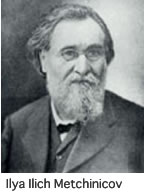|

Mechnikov(1)
Nobel laureate who presented the world’s first scientific evidence that yogurt is an excellent food to consume for health and longevity
|
Ilya Mechnikov (1845-1916)
Mechnikov, who won the Nobel Prize for his immune phagocytosis theory, proposed a theory in his final years of life that aging was accelerated by intestinal decay, and tried to prove it by consuming Bulgarian yogurt in a self-experiment. Today it has been proven that Mechnikov’s belief was correct, and the fact that the term “probiotics*1” has made its way into our common vocabulary attests to his foresight. |
 |
 |
Noticing the function of intestinal bacteria
Mechnikov, born in Ukraine in 1845, set out on his scholarly journey at a local university in the field of protistology. Due to the outstanding results he was able to achieve during his undergraduate research, Mechnikov was invited by universities and research institutions in various European countries to continue his research work there, where he also showed excellent performance and cemented his status as a leading zoologist and phagocytologist.
When the cholera outbreak of 1882 occurred in southern France and surrounding areas, Mechnikov traveled to the region with a colleague, and ingested Vibrio cholera, the bacterium that was the cause of the epidemic. Although neither of the two had previously been infected by the bacterium, Mechnikov did not get cholera while his colleague did. Mechnikov therefore suspected that it might have something to do with the microbiota residing in their intestines (intestinal microbiota). Mechnikov’s theory was that the bacteria in the intestines might have been able to thwart the attacks of exogenous cholera-causing bacteria and prevent their proliferation, while cholera manifested in his colleague likely due to weaker intestinal microbiota. This was probably the first time for Mechnikov to publicly touch on the topic of intestinal bacteria.
Subsequently, Mechnikov received an invitation from the Pasteur Institute*2, the most prestigious place for studying bacteriology at the time, where he was put in charge of an entire research division and continued to actively conduct research.
When he turned 50, Mechnikov became increasingly interested in launching full-scale research on the mechanism of aging.
Aging explained as autotoxication caused by decay in the intestines
Mechnikov believed that aging was caused by the deterioration of cells that made up human organs, resulting in phagocytes feeding on those cells. He thought that the toxin produced by the putrefactive bacteria living in the intestines was causing chronic toxication, which in turn facilitated the process of aging.
While most advanced animals are equipped with both small and large intestines, Mechnikov viewed the large intestines as a non-essential relic inherited from our ancestors, whose sole function was to temporarily store excrement, whereas the small intestines were a necessary organ for absorbing nutrients to sustain life.
Adoption of dietetic treatment involving Bulgarian yogurt in a self-experiment
Although Mechnikov hypothesized that the large intestines no longer had any use, of course he could not have them removed by surgery. Instead, he reasoned that he might be able to prevent the decay by consuming yogurt, allowing the lactic acid bacteria in the yogurt to deter the activity of putrefactive bacteria*3. Based on this theory, Mechnikov went on a dietetic treatment of ingesting yogurt brought from Bulgaria, which was known for having many people who lived longer than usual. In this self-experiment, which he would continue until he died, Mechnikov avoided ingesting any raw food in order to prevent any harmful bacteria from entering the intestines.
Mechnikov later published this concept in 1901, referring to those particular cells as “flora inside the human body.”
However, as his ideas were still just a theory at that point, Mechnikov continued his research to decipher the mechanism of aging and intestinal decay to corroborate his belief, with unfading enthusiasm.
Notes
*1:Probiotics
The term “probiotics” suddenly gained significance in 1969 because of one paper published in the U.K. that year suggesting that we should stop adding antibiotics to livestock fodder to improve their productivity.
At the time, it was gradually becoming common knowledge that farm animals had their own intestinal microbiota unique to each species, and that its proper maintenance was crucial for preventing them from catching communicable diseases while enhancing their productivity. Over time, the consensus grew that probiotics were equivalent to the opposite of antibiotics. In 1989, U.K. microbiologist Dr. Fuller defined probiotics as “live microbial feed supplements which beneficially affect the host animal by improving its intestinal microbial balance” while stressing the important fact that they were living microorganisms and not inanimate substances, which still remains applicable today. Another common definition of probiotics is that they are live bacteria that perform useful functions inside the intestines, and so any foods and live bacterial drugs and that contain probiotics are also considered probiotics.
The definition of the term has been revised several times over the years because of the greater understanding of probiotics that they are actually important for humans as well as for livestock and other animals. There is even a group of scientists who are suggesting expanding the definition of the term to encompass all living microorganisms that have useful functions for any other organisms. The intestines are not the only organs that are inhabited by bacteria; indeed, they exist in large numbers on the skin, inside the mouth, and in the respiratory system. It is now known that various infectious diseases could be caused by the loss of balance in the bacteria’s small ecosystem. Although science is yet to find bacteria that can effectively prevent infectious diseases, there are high expectations that probiotics will play a key role in this endeavor.
|
*2:Pasteur Institute
The Pasteur Institute is a comprehensive microorganism research center, which was founded in 1887 by Dr. Pasteur, a French scientist who invented the vaccine for rabies. It is run with the support of large international donations, and consists of five different disciplinary divisions. The Institute, staffed with leading scientists from all over the world, conducts cutting-edge scientific studies on a wide range of topics, and still continues to thrive as a premier research organization.
When Mechnikov joined the Institute shortly after its opening, he was seen constantly walking around on campus, wearing his trademark cloak that was so long it nearly dragged on the ground. With his unique character and unrelenting approach to his studies unlike any others, Mechnikov earned the nickname “the demon of science” and was considered in a league of his own.
If you visit the Pasteur Museum today, you’ll see a portrait of Mechnikov hung next to that of Pasteur’s, and also his remains stored in a small box made of marble in accordance with his last will. |
 |
 |
*3: Putrefactive bacteria
These are bacteria that break down proteins in the intestines and produce harmful or putrefactive substances such as ammonia, hydrogen sulfide, amine, indole, and phenol. These substances give off foul odors and are the cause of fecal smell. They are also known to become carcinogens and promote the formation and development of cancer. The bacteria that cause diarrhea and enteritis are all putrefactive bacteria.
|






